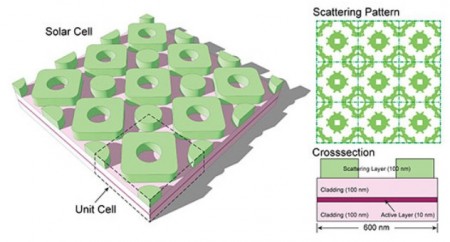Jan
29
Natural Geometry Makes More Efficient Solar Cells
January 29, 2013 | Leave a Comment
Researchers at Northwestern University’s McCormick Department of Mechanical Engineering have developed a new design for organic solar cells that could lead to more efficient, less expensive solar power. The battle on production expense for silicon cells has an estimated 10 times cost disadvantage to coal, transmission and distribution costs. So it’s a long climb. Organic polymer solar cells that use organic materials to absorb light and convert it into electricity could be a solution, but current designs are at an efficiency disadvantage because polymers have less-than-optimal electrical properties.

Natural Geometry Designed Solar Scattering Layer From Northwestern is a geometrically-patterned light scattering film of organic polymer that could make solar cells more efficient and less expensive. Click image for the largest view.
The Northwestern idea of developing organic solar cells could lead to more efficient, less expensive solar power. Instead of attempting to increase efficiency by altering the thickness of the solar cell’s polymer layer – a tactic that has preciously garnered mixed results – the researchers sought to design the geometric pattern of the scattering layer to maximize the amount of time light remained trapped within the cell.
Using a mathematical search algorithm based on natural evolution, the researchers pinpointed a specific geometrical pattern that is optimal for capturing and holding light in thin-cell organic solar cells.
The resulting design exhibited a three-fold increase over the Yablonovitch Limit, a thermodynamic limit developed in the 1980s that statistically describes how long a photon can be trapped in a semiconductor.
In the newly designed organic solar cell, light first enters a 100-nanometer-thick “scattering layer,” a geometrically-patterned dielectric layer designed to maximize the amount of light transmitted into the cell. The light is then transmitted to the active layer, where it is converted into electricity.
Cheng Sun, assistant professor of mechanical engineering, corresponding and co-author of the paper said, “We wanted to determine the geometry for the scattering layer that would give us optimal performance. But with so many possibilities, it’s difficult to know where to start, so we looked to laws of natural selection to guide us.”
Wei Chen, Wilson-Cook Professor in Engineering Design and professor of mechanical engineering at McCormick also a corresponding and co-investigator of the research explains with a bit more depth how they employed a genetic algorithm, a search process that mimics the process of natural evolution, “Due to the highly nonlinear and irregular behavior of the system, you must use an intelligent approach to find the optimal solution,” Chen said. “Our approach is based on the biologically evolutionary process of survival of the fittest.”
The team with co-lead authors Chen Wang and Shuangcheng Yu, graduate students at McCormick, began with dozens of random design elements, then “mated” and analyzed their offspring to determine their particular light-trapping performance. This process was carried out over more than 20 generations and also accounted for evolutionary principles of crossover and genetic mutation.
The resulting pattern will be fabricated with partners at Argonne National Laboratory.
The real world test is yet to come. Whether or not the first round hits some great result might not be so influential as the genetic algorithm search process technique. The follow on steps with the human intellectual mating and analysis blends intuition and computational power in a fascinating way.
Solar cells need every breakthrough possible for economic survival – sometimes the ability to allow serious consideration in many possible situations is challenging now. It’s refreshing that no fantastic efficiency claims are being made.
Still the genetic algorithm search process technique might be the real news leader over time. The team has shown a very innovative route for examining new ideas.

